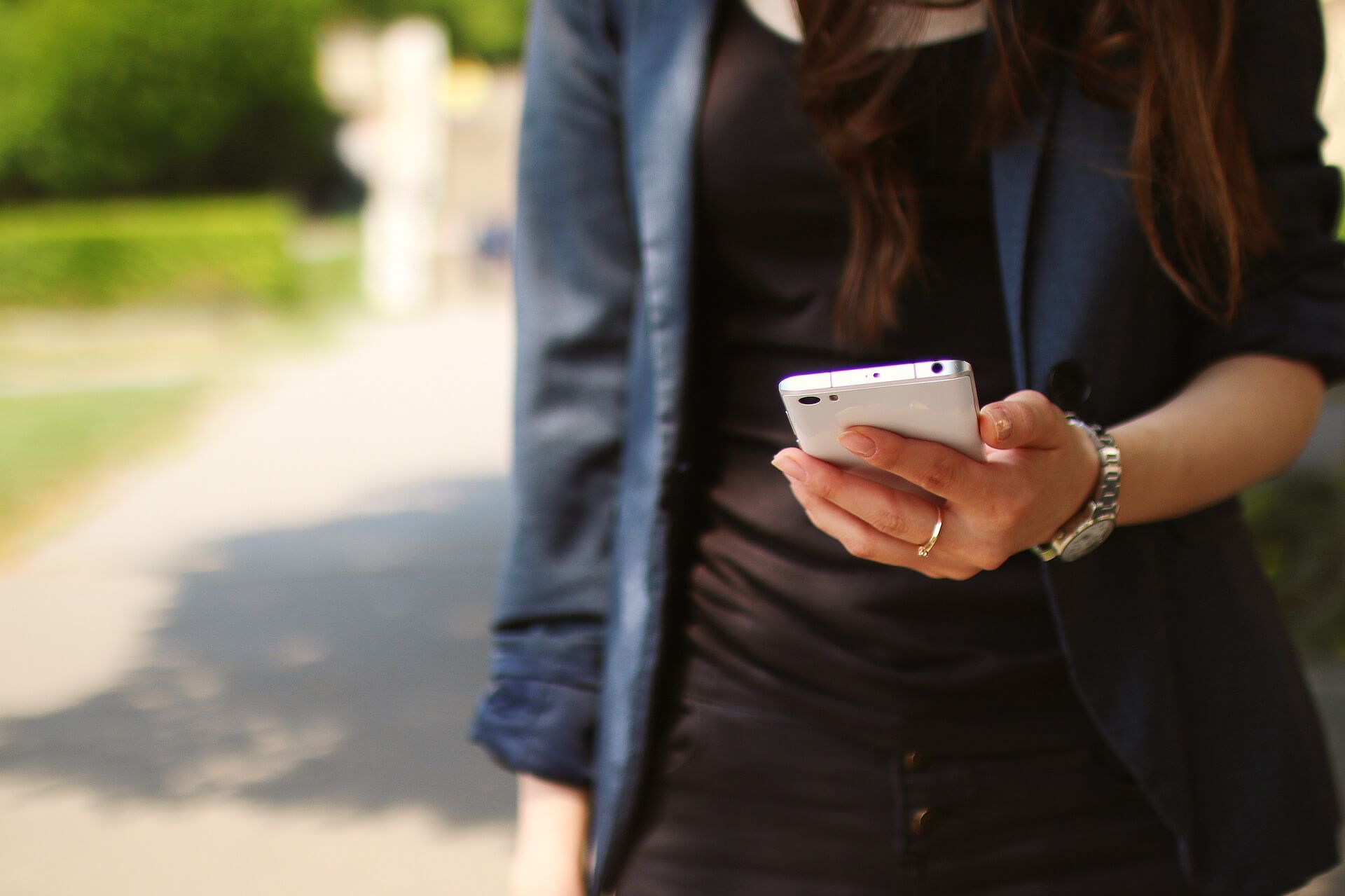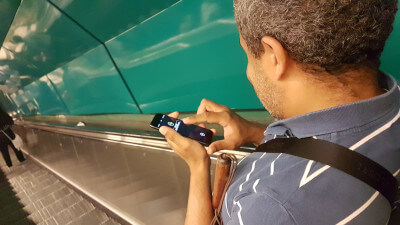
For people with a visual impairment, accessing simple information can sometimes be difficult. How can a nonsighted person get their bearings and choose the best route to get to their destination? Or read a document that’s not available in braille? Answer an email from a co-worker? Fortunately, technology keeps innovating: a lot of apps are specifically designed to help blind or visually impaired people in their everyday lives.
Indeed, 89% of them have a smartphone, a tool that truly revolutionizes their lives. If they can gain more autonomy today, it’s thanks to features that are more advanced and accessible to the general public or thanks to apps that are specially designed for them. Blind or visually impaired people who find it restrictive and stressing to get around can now be more serene.
Let’s explore the apps used by blind or visually impaired people to gain more autonomy in their everyday lives!
VoiceOver
VoiceOver is a screen reader that’s integrated into iPhones that, as its name indicates, enunciates emails or other textual messages aloud. It’s up to the user to choose the speaking rate and the volume.
Not to forget that braille also remains an option for those who have a braille keyboard to connect to the smartphone or who just want to write in braille directly on the screen of their iPhone.
VoiceOver also describes all the elements on the screen such as apps icons, the battery level and even in part images thanks to artificial intelligence. All the information is thus accessible!
TalkBack
Android smartphones also have a similar screen reader with TalkBack. It follows the same guideline as for iPhones: reading textual elements aloud, exploring the screen, using braille with BrailleBack… Everything is set for an optimal and smooth navigation!
Siri
Directly integrated into iPhones, Siri is an easy-to-use vocal assistant. For blind or visually impaired people, for whom finding and clicking on the right button can be difficult, using a voice control enables them to save time!
They just need to ask Siri to call a contact, to send a dictated text message and everything is therefore easier!
Google Assistant
Also activated by voice control, Google Assistant has the same functionality as Siri. The user totally controls their smartphone according to their needs: sending an email, setting up an alarm, managing their schedule…
Available on both Android and iOS
Google Maps
It’s one of the most popular GPS navigation apps. Being able to anticipate their route is essential for blind and visually impaired people. And this also applies for other types of profiles in general since people with disabilities use 30% more the GPS on their smartphone than the rest of the population. (Find out all the facts and figures concerning their use of smartphones in our infographic.)
Google Maps enables users to have access to all the real-time traffic information which is ideal when choosing the right means of public transportation!
The app even provides a new feature called “Accessible Places” that enables users to even more apprehend their environment thanks to information concerning the seating plan of a restaurant, the exact location of a building entrance…
The app provides precious help for blind and visually impaired people to serenely get around!
Available on both Android and iOS
Moovit
For those who are used to taking public transportation, this app lists all the possible means of transportation, their itineraries, their timetables and other information on real-time traffic.
The app even indicates the users the names of stops while on the bus, the tram or the subway. This proves to be essential for blind or visually impaired people when voice announcements aren’t activated.
Available on both Android and iOS
Evelity
Developed by Okeenea Digital, this app is the first indoor wayfinding solution for people with a visual impairment to navigate in complex venues such as museums or universities! Evelity works like a GPS.
Compatible with VoiceOver and TalkBack, the app provides audio instructions to blind and visually impaired people to guide them step by step. People with disabilities can easily find the reception desk or the classroom without needing to know the premises in advance.
Evelity is currently being tested at the Jay Street-MetroTech subway station in New York City!
Other places in France have been equipped with this app to guide blind and visually impaired people: the metro network of Marseilles, the LUMA Foundation and a medical university in Lyon.
Available on both Android and iOS
MyMoveo
We’re once again on the theme of mobility with MyMoveo developed by Okeenea Tech. This app enables blind or visually impaired users to activate connected Accessible Pedestrian Signals aBeacon to know when the pedestrian signal is green and thus safely cross the street.
Users can even use the app to activate the audio beacons NAVIGUEO+ HIFI which can locate points of interest such as the entrances of a public building or a subway station.
Available on both Android and iOS, an update is coming!
Be My Eyes
An app with which users can ask the help of sighted users in order to match their clothes or to know the expiry date of a product. Thanks to an audio-video connexion, users can easily get in touch.
Available on both Android and iOS
Aira
Aira works in the same way as Be My Eyes since it connects nonsighted people with sighted ones to help them in various tasks such as finding the gate of an airport.
What sets this app apart is that the sighted users, called agents, are specifically trained to assist blind or visually impaired users referred to as Explorers.
Although the app can be downloaded for free, users are charged according to the different plans and services Aira provides. Depending on the formula they choose and their needs, the cost can thus be high.
Available on both Android and iOS
Seeing AI
A multipurpose app that permits to read and describe all types of documents placed under the smartphone camera such as banknotes or product barcodes.
Seeing AI even recognizes images, colors and faces and thus gives details on people’s emotions.
Apps such as Seeing AI are truly groundbreaking for blind and visually impaired people who can still see their environment in a different way.
Available on iOS
Lookout
Lookout is the equivalent app of Seeing AI on Android. The user just has to activate their smartphone camera so that Lookout can identify banknotes, objects… Thanks to its Quick Read Mode, the app skims through a text which is ideal when sorting the mail for example.
An app that enables blind and visually impaired people to simplify their everyday tasks and to save time!
Available on Android
We can see that blind or visually impaired people can use a lot of apps to improve their autonomy especially concerning their mobility.
If you want to know more about people with a visual impairment, you can read our articles:
8 Key Points to Ensure Accessibility for Customers with a Vision Disabilities at Public Venues
6 Tips to Communicate with a Blind or Visually Impaired Person
How Do the Blind Safely Cross the Road?
Updated on March 29th, 2023 / Published on October 30th, 2020
media

The app Evelity is the first indoor wayfinding solution for people with a visual impairment to navigate in complex venues such as museums or universities! It works like a GPS.
writer

Carole Martinez
Content Manager
stay updated
Get the latest news about accessibility and the Smart City.
other articles for you

Open Data Is Key to Fostering Universal Accessibility
Open data represents an opportunity for cities to reach universal accessibility. It shows the missing links of the mobility chain.
Our Audio Beacons Guide the Blind and Visually Impaired at the Helsinki Subway
The Helsinky subway improved their audio signage system by installing on demand and remotely activated audio beacons.
7 Good Reasons to Install Audio Beacons at Your Public Transport Network
Audio beacons are an efficient way to provide more autonomy to blind and visually impaired people. They can easily use public transport.

Will Remote Activation Become the Norm for Accessible Pedestrian Signals?
More and more cities like New York have been exploring remote activation to trigger accessible pedestrian signals.
share our article!
more articles

Disability Statistics in the US: Looking Beyond Figures for an Accessible and Inclusive Society
Disability Statistics in the US: Looking Beyond Figures for an Accessible and Inclusive Society Around 61 million adults in the United States live with a disability. Diving into disability statistics in the US will help us know exactly who is concerned and what...
Our Audio Beacons Guide the Blind and Visually Impaired at the Helsinki Subway
Our Audio Beacons Guide the Blind and Visually Impaired at the Helsinki SubwayOur audio beacons equip the new line of the Helsinki subway in Finland. They help blind and visually impaired people locate the points of interest of a station. For users with visual...

Will Remote Activation Become the Norm for Accessible Pedestrian Signals?
Will Remote Activation Become the Norm for Accessible Pedestrian Signals?Without pushbutton, there are no accessible pedestrian signals. That’s how APS work in the U.S. But more and more cities have been exploring remote activation like New York City. The Department...

Hearing Impaired People: a Multitude of Profiles for Different Needs
Hearing Impaired People: a Multitude of Profiles for Different Needs Did you know that hearing impaired people have several profiles and that the way they identify themselves is important? You may be familiar with deaf and hard of hearing people but for each of...
NEVER miss the latest news about the Smart City.
Sign up now for our newsletter.
Unsubscribe in one click. The information collected is confidential and kept safe.
powered by okeenea
The French leading company
on the accessibility market.
For more than 25 years, we have been developing architectural access solutions for buildings and streets. Everyday, we rethink today’s cities to transform them in smart cities accessible to everyone.
By creating solutions ever more tailored to the needs of people with disabilities, we push the limits, constantly improve the urban life and make the cities more enjoyable for the growing majority.


